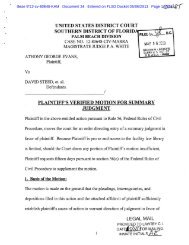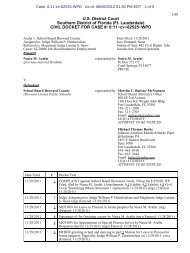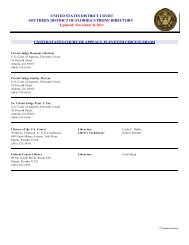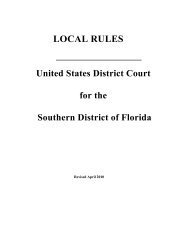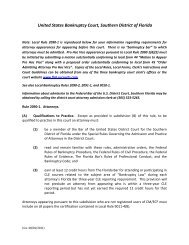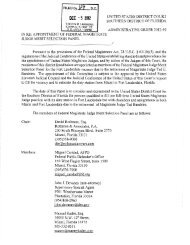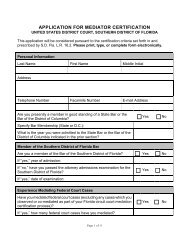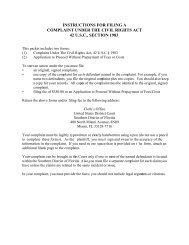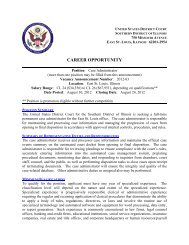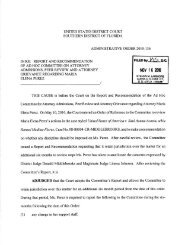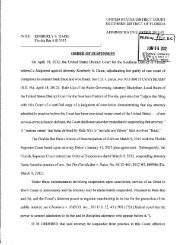JAN j 6 2010 - United States District Court
JAN j 6 2010 - United States District Court
JAN j 6 2010 - United States District Court
You also want an ePaper? Increase the reach of your titles
YUMPU automatically turns print PDFs into web optimized ePapers that Google loves.
B. Procedures Governing Manner of Production.<br />
(1) Production of Documents, Electronically Stored Information and<br />
Things. When discovery materials are being produced (unless the case is<br />
a massive one) the following general guidelines, which may be varied to<br />
suit the needs of each case, are normally followed:<br />
a. Place. The request may as a matter of convenience suggest production<br />
at the office of either counsel. The <strong>Court</strong> expects the lawyers to<br />
reasonably accommodate one another with respect to the place of<br />
production.<br />
b. Manner of Production. The entire production should be made available<br />
simultaneously, and the inspecting attorney or paralegal can determine<br />
the order in which to review the materials. While the inspection is in<br />
progress, the inspecting person shall also have the right to review again<br />
any materials which have already been examined during the inspection.<br />
The producing party has an obligation to explain the general scheme of<br />
record-keeping to the inspecting party. The objective is to acquaint the<br />
inspecting party generally with how and where the documents,<br />
electronically stored information or things are maintained. The<br />
documents, electronically stored information or things should be<br />
identified with specific paragraphs of a request for production where<br />
practicable, unless the producing party exercises its option under<br />
Federal Rule of Civil Procedure 34(b) to produce documents as they are<br />
kept in the usual course of business. Generally, when materials are<br />
produced individually, each specific item should be identified with a<br />
paragraph of the request. When materials are produced in categories or<br />
in bulk, some reasonable effort should be made to identify certain groups<br />
of the production with particular paragraphs of the request or to provide<br />
some meaningful description of the materials produced. The producing<br />
party is not obligated to rearrange or reorganize the materials.<br />
Obviously, whatever comfort and normal trappings of civilization that are<br />
reasonably available should be offered to the inspecting party.<br />
c. Listing or Marking. Federal Rule of Civil Procedure 26(a)(1)(B),<br />
requires a party, without awaiting a discovery request, to provide the<br />
other parties with a copy of, or a description by category and location,<br />
of all documents, electronically stored information and tangible things<br />
that are in possession, custody, or control of the party and that the<br />
disclosing party may use to support its claims or defenses, unless solely<br />
for impeachment. A party producing documents in discovery shall<br />
sequentially number the pages produced and precede the numbers with a<br />
unique prefix, unless so marking a document would materially interfere<br />
with its intended use or materially damage it (e.g., an original<br />
promissory note or other document of intrinsic value). In the event the<br />
party produces documents as kept in the ordinary course of business, the<br />
producing party's obligation to sequentially number the pages applies to<br />
the documents selected for production by the receiving party. When<br />
documents produced in response to a request for production exceed fifty<br />
pages, counsel for the party producing the documents shall affix Bates-<br />
stamped numbers to each page so that the documents produced can be<br />
95



